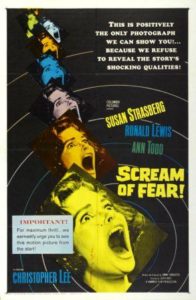“I can watch people’s eyes, and they can’t see mine.”
— Penny Appleby’s (Susan Strasberg) explanation as to why she wears sunglasses
Although founded in 1934, the most representative of the Hammer horror films are those made between the mid-1950s and the 1970s—excesses of blood, a somewhat audacious style, the frequent garish Technicolor (where are the watchdogs of that company’s technical standards such as Natalie Kalmus?) and a general lack of imagination and subtlety. But at most, perhaps, the films provide solid, scary middlebrow entertainment—there are worse movies in the genre—and the best included two revived series, Frankenstein and Dracula, making stars of Christopher Lee and Peter Cushing.
Set apart from this cauldron of gore and violence came, in 1961, what Lee called the best of the Hammer films. Scream of Fear is free of laboratory monsters, bloodsucking vampires and night-prowling werewolves, Technicolor is now replaced by dramatic, shadowy black and white and the plot is more a mystery than a horror exercise, with enough suggestions of horror to make the spine tingle more than just a little. Some suspicion is infused from the start—a body dredged from a lake, a father expected to meet his daughter but away on business and conflicting reasons for his absence given by a stepmother and a chauffeur. And that’s just the beginning. . . .
There has to be a big house in these things, so the big old, gloomy mansion, the long drive to the front door, the absent music score in the beginning—all include some of the elements of a similar film, made the same year, The Innocents, starring Deborah Kerr and based on the novel The Turn of the Screw by Henry James. Although this may be a slightly better film and with a different plot, the same hovering, unsettling atmosphere is present in the one from Hammer.
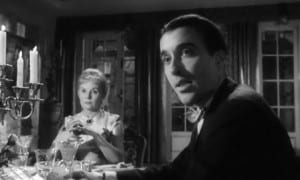 In Scream of Fear, Christopher Lee is credible as an on-the-surface nice guy but with an ominous air of insincerity. Or maybe that insincerity is only superimposed by some viewers, based on Lee’s typical roles; it could be possible that here he isn’t playing a typical role. His equally able co-stars, their names above his in the credits, are Susan Strasberg, daughter of the famous Lee Strasberg, proponent of method acting; Ronald Lewis, a Welsh actor whose best role this might be; and Ann Todd, best remembered as the harassed piano pupil of James Mason in The Seventh Veil.
In Scream of Fear, Christopher Lee is credible as an on-the-surface nice guy but with an ominous air of insincerity. Or maybe that insincerity is only superimposed by some viewers, based on Lee’s typical roles; it could be possible that here he isn’t playing a typical role. His equally able co-stars, their names above his in the credits, are Susan Strasberg, daughter of the famous Lee Strasberg, proponent of method acting; Ronald Lewis, a Welsh actor whose best role this might be; and Ann Todd, best remembered as the harassed piano pupil of James Mason in The Seventh Veil.
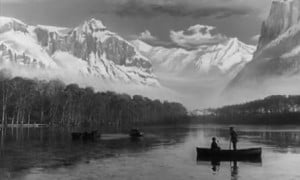 Music in absent in the beginning, neither supporting Columbia’s trademark lady with the torch (the film’s distributor), nor during the scene at a lake in what appears to be the Austrian Alps. Only the sounds of birds chirping. In a rowboat, two German-speaking men, neither overly concerned with their task, are trawling the water with an oar. Presently they pull a body, a woman’s body, into the boat. Still no music, only the birds chirping.
Music in absent in the beginning, neither supporting Columbia’s trademark lady with the torch (the film’s distributor), nor during the scene at a lake in what appears to be the Austrian Alps. Only the sounds of birds chirping. In a rowboat, two German-speaking men, neither overly concerned with their task, are trawling the water with an oar. Presently they pull a body, a woman’s body, into the boat. Still no music, only the birds chirping.
Then follows the main title credits and the first appearance of Clifton Parker’s music, an innocuous lyrical tune that belies the import of what is to come, certainly the antithesis of what has just been seen. It is important to mention here that the musical score is used sparingly, the temptation resisted, supposedly by both Parker and others, to saturate a horror movie, which this film really isn’t, with scary music. When bloodcurdling music is required, it comes forth, more than adequately. Even then it’s respectably short of being over the top. Without music are any number of scenes with strange noises or lights, or when a wheelchair occupant maneuvers into a dark room, when something is obviously about to happen.
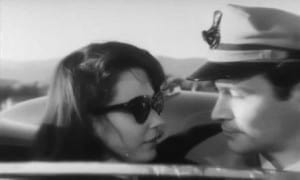 After the credits, a TWA jet lands at Nice-Cote d’Azur Airport, France. A chauffeur, Robert (Lewis), meets a passenger, Penny Appleby (Strasberg), who is wheelchair-bound. He lifts her into the back seat of a Rolls-Royce and places her wheelchair in the trunk. As they ride along, she asks him why her father, whom she hasn’t seen in ten years, didn’t come to meet her. Robert replies simply, “He’s away.”
After the credits, a TWA jet lands at Nice-Cote d’Azur Airport, France. A chauffeur, Robert (Lewis), meets a passenger, Penny Appleby (Strasberg), who is wheelchair-bound. He lifts her into the back seat of a Rolls-Royce and places her wheelchair in the trunk. As they ride along, she asks him why her father, whom she hasn’t seen in ten years, didn’t come to meet her. Robert replies simply, “He’s away.”
At the palatial mansion, Penny meets for the first time her stepmother, Jane (Todd), and later remembers her real mother who had drowned years ago, rather mysteriously, as she was a good swimmer. From her room that night, Penny wheels herself outside and into the summer house. She sees a white-haired man, her father, sitting in a chair. He is dead, a lighted candle on the floor in front of him. She screams, and in her panic to escape, steers her wheelchair into a small pool. Robert rescues her.
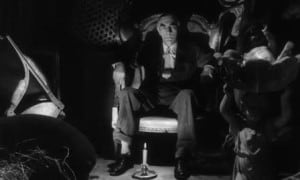 Penny wishes to return to the summer house, now accompanied by Robert, Jane and a friend of her father’s, a dining guest, Dr. Pierre Gerrard (Lee, with a slender French accent). But there is no sign of a body—or the candle. Everyone suggests Penny was merely imagining things, and Jane explains that a candle was unnecessary, as there is electricity in the summer house.
Penny wishes to return to the summer house, now accompanied by Robert, Jane and a friend of her father’s, a dining guest, Dr. Pierre Gerrard (Lee, with a slender French accent). But there is no sign of a body—or the candle. Everyone suggests Penny was merely imagining things, and Jane explains that a candle was unnecessary, as there is electricity in the summer house.
Next day, Jane announces she has a surprise for Penny—her father is on the phone. He says it’ll be a couple of days before he arrives. Later, the chauffeur, who seems to feel sympathy for the young girl, says that he did find some candle wax in the summer house, and, between them, they wonder how Dr. Gerrard arrived at the house, as he doesn’t drive and Robert didn’t pick him up.
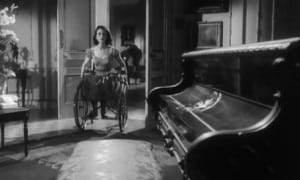 More strange happenings occur. The key to the summer house disappears from its usual place. Penny sees her father’s small, white sports car in the garage, but Jane tells her she was just in the garage and there was no car. Penny hears someone playing the piano—Chopin’s E-Minor Prelude—and enters to find the piano lid locked. Jane tell her that no one could play the piano but her father.
More strange happenings occur. The key to the summer house disappears from its usual place. Penny sees her father’s small, white sports car in the garage, but Jane tells her she was just in the garage and there was no car. Penny hears someone playing the piano—Chopin’s E-Minor Prelude—and enters to find the piano lid locked. Jane tell her that no one could play the piano but her father.
One night, from outside, Penny sees a light in her room and someone’s shadow move across the curtained window. Inside, she sees her father in a chair, his dead face falling forward as she stares at him. She screams. But later no body is found. Robert says, “You weren’t imagining things, were you?” He correctly surmises that her father was a rich man, and Penny confirms that after his death—and her own—Jane would stand to inherit quite a bit.
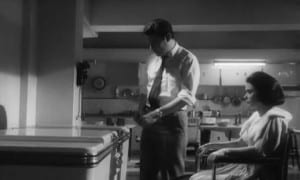 Penny and Robert, together, believe Jane and Dr. Gerrard might be attempting to drive Penny crazy and decide that finding the body of Mr. Appleby would provide the necessary evidence to support their theory. They look in the deep freezer, Robert unscrewing the plates that secure the lock. No body.
Penny and Robert, together, believe Jane and Dr. Gerrard might be attempting to drive Penny crazy and decide that finding the body of Mr. Appleby would provide the necessary evidence to support their theory. They look in the deep freezer, Robert unscrewing the plates that secure the lock. No body.
In the meantime, from a high terrace Jane sees Robert kiss Penny along the rocky seacoast and wonders to Penny if the two are becoming close.
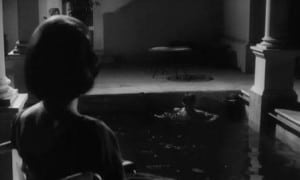 Then Penny thinks to herself and looks ahead at the pool—yes, the pool, the pool! Why didn’t they think before of looking there? Robert dons a swimsuit and dives in. “Dark as night,” he says after a first dive, having seen nothing. On his second dive he sees a man, seeming to sit upright, staring ahead as if alive, his abundant white hair motionless (no movement in the water?). Now, with the needed evidence, Robert lifts Penny into the Rolls-Royce and they ride along the rocky coast toward the police station. Ahead of them, alongside the road, they see Jane on foot. Robert stops the car: foolish to drive on, he says, as Jane knows the car. While he has stepped outside to talk to Jane, the car begins to roll forward. . . .
Then Penny thinks to herself and looks ahead at the pool—yes, the pool, the pool! Why didn’t they think before of looking there? Robert dons a swimsuit and dives in. “Dark as night,” he says after a first dive, having seen nothing. On his second dive he sees a man, seeming to sit upright, staring ahead as if alive, his abundant white hair motionless (no movement in the water?). Now, with the needed evidence, Robert lifts Penny into the Rolls-Royce and they ride along the rocky coast toward the police station. Ahead of them, alongside the road, they see Jane on foot. Robert stops the car: foolish to drive on, he says, as Jane knows the car. While he has stepped outside to talk to Jane, the car begins to roll forward. . . .
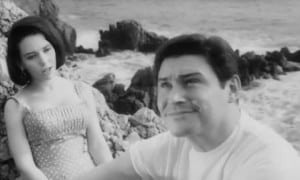 No! No more. This is one film, among all those reviewed under this byline, where no spoilers will be permitted. Revealing anything more beyond this point about this movie, and this movie in particular, would be criminal. Although a big initial success, both in the U.S. and in England, where it was made under the title Taste of Fear, the film is less well known now. There are any number of fans of this genre who will be totally mesmerized by this movie, and surprised that it is from Hammer, surprised that it is—well, so good.
No! No more. This is one film, among all those reviewed under this byline, where no spoilers will be permitted. Revealing anything more beyond this point about this movie, and this movie in particular, would be criminal. Although a big initial success, both in the U.S. and in England, where it was made under the title Taste of Fear, the film is less well known now. There are any number of fans of this genre who will be totally mesmerized by this movie, and surprised that it is from Hammer, surprised that it is—well, so good.
Rest assured, no character is who or what he or she appears to be. The wheelchair, often assuming an importance all its own, is sometimes seen in single, isolated shots. Let’s say, it has a key “role” in the final scene. To further put off the scent those who think they have figured it out—surely not on this brief synopsis alone!—there’s this closing line of the film: “Come away, Maggie. There’s nothing more for you here.”
Who’s “Maggie”?!
